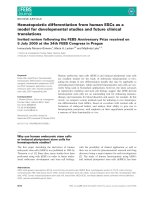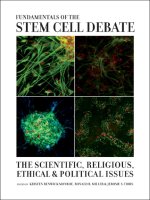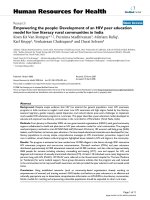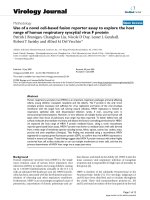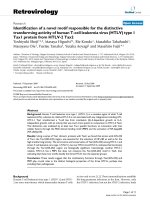Development of human stem cell based model for developmental toxicity testing
Bạn đang xem bản rút gọn của tài liệu. Xem và tải ngay bản đầy đủ của tài liệu tại đây (5.11 MB, 165 trang )
DEVELOPMENT OF HUMAN STEM CELL-BASED MODEL
FOR DEVELOPMENTAL TOXICITY TESTING
XING JIANGWA
(BME, SHANGHAI JIAO TONG UNIVERSITY, CHINA)
A THESIS SUBMITTED
FOR THE DEGREE OF DOCTOR OF PHILOSOPHY
MECHANOBIOLOGY INSTITUTE
NATIONAL UNIVERSITY OF SINGAPORE
2015
ii
Acknowledgements
First of all, I would like to extend my great gratitude and sincere
appreciation to my PhD supervisor Prof. Hanry Yu for his enduring
mentorship and support. His training for not only being a good researcher but
also being a good team leader and member was extremely helpful for me. His
passion for translational research inspires me along the way. Great thanks are
extended to Dr. Yi-Chin Toh, who was a former lab member as Research
Scientist in IBN and now working as Assistant Professor in NUS. She has
been a great mentor, helpful colleague and kindest friend to me along my PhD
study. My project wouldn’t move forward smoothly without her valuable
advice and contributions. I really enjoy working and having various
discussions with her about science and life. I am very grateful for my Thesis
Advisory Committee (TAC) members, Prof. Yusuke Toyama, and Prof.
Sungsu Park as well. They have raised critical questions for my project and
provided me many useful suggestions both for my project and for my personal
development as a PhD candidate.
Next I would like to thank my great lab members for their generous
support. Great thanks should be extended to my senior Dr. Shuoyu Xu, who
helped me a lot in image processing. I’m grateful to other team project
members I have been happily working with, Dr. Farah Tasnim, Dr. Huan Li,
Ms. Yinghua Qu and Dr. Junjun Fan. I have learned how to work in a team
and utilize everyone’s specialties to best contribute to the projects. I would
like to thank Ms. Wai Han Lau, Dr. Shu Ying Lee and Mr. Weian Zhang for
iii
their help in microscopy. Great thanks are extended to Ms. Wenhao Tong, Ms.
Qiwen Peng and Ms. Jie Yan, who used to seat in the same office with me. We
were all Sagittarius PhD candidates of similar age, and shared quite a lot sweet
and bitter memories together. The courage and support we gave to each other
means a lot to my PhD life.
Sincere appreciation should also be given to my parents, who have shown
great understanding and support to my PhD study here in Singapore. I’m also
quite grateful to Prof. Chwee Teck Lim, Prof. Shivashankar G V, Dr. Man
Chun Leong and Dr. Shefali Talwar for their guidance during my lab rotation
four years ago, who actually introduced me to cell-related biological research
and taught me practical techniques I could use throughout these four years. I
would like to thank IBN and BMRC for their generous financial supports for
research and MBI for my scholarship. Last but not least, I would like to thank
Prof. Yanan Du for his scientific inputs during my PhD qualification exam,
and thank all the thesis examiners for their precious time in evaluating this
thesis.
i
Table of Contents
1. Introduction 1
2. Background and Significance 4
2.1 Embryogenesis 4
2.1.1 Mammalian embryogenesis 4
2.1.2 Biochemical control during gastrulation 9
2.1.3 Mechanical control in cell fate determination and morphogenesis
during gastrulation 12
2.2 Developmental toxicity 15
2.2.1 Birth defects and developmental toxicity 15
2.2.2 In vivo animal studies for developmental toxicity testing 17
2.3 In vitro animal-based models for developmental toxicity testing 18
2.3.1 The MM assay 19
2.3.2 The WEC assay 21
2.3.3 The zebrafish model 23
2.3.4 The mEST 25
2.4 In vitro hPSC-based models for developmental toxicity testing 27
2.4.1 The metabolite biomarker-based hPSC teratogenicity assay 28
2.4.2 The hPST using mesoendoderm differentiation 31
2.4.3 Summary 34
3. Specific aims 35
4. E-cadherin mediated spatial differentiation of hPSCs within 2D cell
colony 37
4.1 Introduction 37
4.2 Materials and Methods 39
4.2.1 hPSC maintenance and differentiation 39
4.2.2 Fabrication of PDMS stencils for micropatterning 40
4.2.3 Generation of micropatterned hPSC (μP-hPSC) colonies 41
4.2.4 Immunofluorescence staining 42
ii
4.2.5 Image acquisition and analysis 43
4.2.6 Inhibition studies 45
4.2.7 E-cadherin Fc (EcadFc)-coated substrates 46
4.2.8 RNA isolation, cDNA synthesis and quantitative RT-PCR 46
4.3 Results 47
4.3.1 Spatial heterogeneity in mesoendoderm differentiation corresponds
to spatial polarization of cell adhesion and actomyosin networks 47
4.3.2 Control over mesoendoderm differentiation patterns by modulating
integrin and E-cadherin adhesions 53
4.3.3 Spatial patterning of mesoendoderm differentiation requires both
integrin and E-cadherin adhesions 59
4.3.4 Integrin adhesion modulates E-cadherin adhesion signaling via Rho-
ROCK-myosin II activity to determine pluripotency-differentiation cell
fates 64
4.4 Conclusion 68
5. In vitro mesoendoderm pattern formation by geometrically confined
cell differentiation and migration 70
5.1 Introduction 70
5.2 Materials and Methods 71
5.2.1 Cell maintenance and differentiation 71
5.2.2 Matrigel
TM
coating 71
5.2.3 Immunofluorescence staining and microscopy 71
5.3 Results 73
5.3.1 Geometrically-confined collective cell migration in μP-hPSC
colonies 73
5.3.2 Formation of an annular mesoendoderm pattern in μP-hPSC
colonies 77
5.3.3 Matrix concentration-dependent collective cell migration in μP-
hPSC colonies 80
iii
5.3.4 Free of line-to-line variability in mesoendoderm pattern formation
82
5.4 Conclusion 83
6. A new method for human teratogen detection by geometrically
confined cell differentiation and migration 85
6.1 Introduction 85
6.2 Materials and Methods 87
6.2.1 Cell maintenance and differentiation 87
6.2.2 Drug preparation 88
6.2.3 Cytotoxicity assay 88
6.2.4 Image analysis 89
6.2.5 Statistical analysis 90
6.3 Results 91
6.3.1 Sensitivity and specificity of mesoendoderm pattern formation to
teratogen treatment 91
6.3.2 A quantitative morphometric assay to classify teratogenic potential
of compounds 94
6.3.3 Evaluation of the morphometric μP-hPSC model in classifying
teratogens 97
6.3.4 Concentration-dependent teratogenicity of compounds 106
6.4 Conclusion 107
7. Conclusions and Recommendations 108
8. References 113
9. Appendices 131
9.1 Cells in μP-hPSC colonies maintained pluripotency in mTeSR
TM
1
maintenance medium 131
9.2 Culture of hPSCs on E-cadherin Fc-coated tissue culture polystyrene
substrates 133
9.3 Integrin and E-cadherin antibody blocking 134
i
Summary
Spatially and temporally organized cell differentiation and tissue
morphogenesis characterize the whole embryo development process, and
unintended exposure to teratogenic compounds can lead to various birth
defects. However, current animal-based models for developmental toxicity
testing is limited by time, cost and high inter-species variability, while human
pluripotent stem cell (hPSC) models are only focusing on recapitulating cell
differentiation with neither spatial control nor morphogenic movements.
In this dissertation, a human-relevant in vitro model, which recapitulated
two cellular events characteristic of embryogenesis, was developed to identify
potentially teratogenic compounds. Firstly mesoendoderm differentiation was
only induced to the periphery of micropatterned hPSC (μP-hPSC) colonies,
where there were higher integrin-mediated adhesions compared with colony
interior. Spatially polarized integrin adhesions in a cohesive hPSC colony
compete to recruit Rho-ROCK activated myosin II away from E-cadherin
mediated cell-cell junctions to promote differentiation at that locality, resulting
in a heterogeneous cell population. When further inducing the mesoendoderm
differentiation from 1 day to 3 days, tissue morphogenesis could be
recapitulated, which was mainly collective cell migration in vitro. Cells at the
colony periphery actually underwent epithelial-mesenchymal transition (EMT)
and directed collective cell migration to form an annular mesoendoderm
pattern which was similar as in vivo. When treated with known teratogens, the
ii
two cellular processes (cell differentiation and collective cell migration) were
disrupted and the morphology of the mesoendoderm pattern was altered.
Image processing and statistical algorithms were developed to quantify and
classify the compounds’ teratogenic potential. The μP-hPSC model not only
could capture the dose-dependent effects of teratogenicity but also could
correctly classify species-specific drug (Thalidomide) and false negative drug
(D-penicillamine) in the conventional mouse embryonic stem cell test. This
model offers a scalable screening platform to mitigate the risks of teratogen
exposures in human.
iii
List of Publications
Jiangwa Xing, Yi-Chin Toh, Shuoyu Xu, Hanry Yu. A method for human
teratogen detection by geometrically confined cell differentiation and
migration. Scientific Reports. 2015. (Accepted)
Yi-Chin Toh, Jiangwa Xing, Hanry Yu. Modulation of integrin and E-
cadherin-mediated adhesions to spatially control heterogeneity in human
pluripotent stem cell differentiation. Biomaterials 50 (2015): 87-97.
Patent
H. Yu, Y.C. Toh, J. Xing, “Method and system for in vitro developmental
toxicity testing”, Singapore Patent granted on Sep. 30 2013:
PCT/SG2013/000426
iv
List of Figures
Figure 2.1.1 Gastrulation in a chick embryo………………………………… 6
Figure 2.1.2 Morphogenetic movements of cells during gastrualtion. (A)
Gastrulation movements can be classified based on the
morphogenetic changes they produce. Epiboly leads to expansion
of tissue, often accompanied by thinning. Emboly or
internalization entails movement of mesodermal and endodermal
precursors from the blastula surface beneath the prospective
ectodermal layer. Convergence narrows tissues mediolaterally,
whereas extension elongates them from head to tail. (B–H) Each
class of gastrulation movements can be achieved by a variety of
morphogenic cell movements… ……………………………….8
Figure 2.3.1 Schematic representation of limb bud cell preparation. Limbs are
dissected from the embryo, trypsinized into single cell
suspension, plated at high density (micromass) and flooded with
medium……………………… 20
Figure 2.3.2 Embryos showing range of development possible in WEC. A:
Gastation day (GD) -9 rat embryo. epc, ectoplacental cone; a,
allantois; emb, embryo; ys, visceral yolk sac. B: GD-12 rat
embryo in enclosed visceral yolk sac. C: GD-12 rat embryo with
visceral yolk sac removed.h, heart; lb, limb bud………………22
Figure 2.3.3 Experimental design of zebrafish developmental assay……… 24
Figure 2.3.4 Different time points in cardiac differentiation of mESCs. (a)
Undifferentiated mESCs cultured in maintenance medium in the
presence of LIF. (b) Hanging drop culture from day 1 to 3 of
v
differentiation. (c) Embryoid body at day 5 of differentiation in
suspension culture. (d) Embryoid body outgrowth at day 10 of
differentiation in 24-well plates. The center of the picture in d
shows the area at which beating cardiomyocytes were
located………………………………………………………….26
Figure 2.4.1 Graphical representation of the classification scheme for known
human teratogens and nonteratogens utilizing the therapeutic
C
max
concentration to set the classification windows. The dose-
response curve for the o/c ratio (purple curve) was fit using a
four-parameter log-logistic model and used to interpolate the
concentration where the o/c ratio crosses the teratogenicity
threshold (i.e., teratogenicity potential, black-bordered red circle).
A test compound was predicted as a nonteratogen when the
teratogenicity potential concentration is higher than the human
therapeutic C
max
(A). A test compound was predicted as a
teratogen when the teratogenicity potential concentration is lower
than the human therapeutic C
max
(B). The x-axis is the
concentration (μM) of the compound. The y-axis value of the o/c
ratio is the ratio of the reference treatment normalized (fold
change) values (ornithine/cystine)…………………………… 29
Figure 2.4.2 The hPST model (a) Schematic figure showing the time line of
mesendoderm differentiation, compound dosing, and
immunostaining. (Adapted from , Fig. 2a). (b) Plot of SOX17
and DAPI TC50 values for 71 tested pharmaceutical compounds.
The colored boxes on the x-axis delineate the compounds tested.
Boxes in red are true positives, blue boxes are true negatives, and
yellow boxes are incorrectly classified at the 30μM SOX17 IC50
threshold……………………………………………………… 33
vi
Figure 4.2.1 Generation of PDMS stencil for micropatterning………………41
Figure 4.3.1 Schematic representation of micropatterning of hPSC colonies
and mesoendoderm induction………………………………….48
Figure 4.3.2 Asymmetric spatial localization of integrin mediated cell-matrix
adhesion in the μP-hPSC colony. Images are
immunofluorescence projections of 3D confocal sections of
integrin β1, vinculin and paxillin before (0 hr) and after (24 hr)
mesoendoderm differentiation. All samples were counter-stained
for F-actin (blue). Scale bar, 20 μm……………………………49
Figure 4.3.3 Asymmetric spatial localization of cell adhesion and actomyosin
contractile networks components preceded and persisted during
mesoendoderm differentiation. Images are immunofluorescence
staining of Brachyuary (T), integrin β1, E-cadherin,
phosphorylated myosin light chain (ppMLC) and F-actin before
(0 hr) and after (24 hr) mesoendoderm differentiation. Inset show
intensity map of T expression in the entire colony. Dotted white
lines denote colony edge. Scale bar, 20 µm in (b), 200 µm in (b,
inset)……………………………………………………………49
Figure 4.3.4 Expression of pluripotency and mesododerm markers in μP-hPSC
colonies after 24 hr of differentiation. (a) Nanog, (b) Fgf8, (c)
Eomes. All samples are counter-stained for Brachyuary, T (red)
and nuclei (blue). Scale bar, 20 μm in (a-c). …………… … 50
Figure 4.3.5 Apical-basal polarization of the actomyosin and actin
cytoskeleton networks within μP-hPSC colonies after 24 hr of
differentiation. (a) T+ cells at the colony periphery had more
distinct apical-basal intracellular polarization of actomyosin and
F-actin cytoskeleton networks. Co-immunostaining of T (red),
vii
ppMLC (green) and F-actin (blue) shows their respective
intracellular localization at the colony periphery and interior.
White arrows denote circumferential actomyosin contractile
cable. (b) Co-immunostaining of ppMLC (green), β-catenin (red)
and F-actin (blue) showing their respective subcellular
localization at the periphery and interior of the µP-hPSC colonies.
Scale bar, 20 µm in (a, b). (c) Quantification of ppMLC
expression at the apical, lateral and basal cellular domains of T+
cells at the periphery of µP -hPSC colonies. Data are average ±
s.e.m of 7 images. *p<005, **p<0.01 (Student’s t-test).…… 52
Figure 4.3.6 (a) Modulating mesoendoderm differentiation by changing the
relative magnitude (with anisotropic geometries) and ratio (with
increased perimeter) of integrin and E-cadherin adhesions. (b)
µP -hPSC colonies of different geometrical shapes but same
colony area. Phase images (top panel) and intensity maps of T
expression (bottom panel) after 24 hr induction. (c) Average T
intensity profiles (along white dotted lines in (a)) in isometric
circular colonies or anisometric square and rectangular colonies.
All colonies had the same area except for one of the circular
colonies, which was 50% smaller (i.e., 50% circle). (d) Average
T intensity profiles from the concave or convex edges into the
colony interior in a semi-circular arc, as indicated by white
dotted lines in (a). Each intensity profile in (c-d) is an average of
16 intensity profiles obtained from 4 colonies. (e) Percentage of
T+ colony area in different colony geometries of the same area.
Data are average ± s.e.m of respective sample sizes (n): circle
(n=8), square (n=8), rectangle (n=7), arc (n=8). (f) Percentage of
T+ colony area in circular colonies of different sizes. Data are
viii
average ± s.e.m of 8 colonies. **p<0.01 (Student’s t-test). Scale
bar, 200 µm in (b) ……………………………………………54
Figure 4.3.7 Exogenously imposed mechanical polarization by
micropatterning alternating strips of MatrigelTM (MG) and E-
cadherin tagged with human Fc fragments (EcadFc) on substrate.
(a) Schematic illustrating asymmetry in cell adhesion modes
within a hPSC colony. (b) µP-hPSC colonies on E-cadherin Fc
(EcadFc)-coated substrates exhibited E-cadherin and ppMLC that
were localized to basal domain in contact with substrate, and
attenuated T expression. Images are confocal sections showing
sub-cellular localization of T, ppMLC and E-cadherin after 24 of
differentiation. White dotted line denotes colony edges. (c)
Quantification of ppMLC expression at the apical, lateral and
basal domains of cells cultured on EcadFc substrates. Data are
average ± s.e.m of 6 images. *p<0.05, **p<0.01 (Student’s t-test).
(d) Immunofluorescence image of T expression on alternating
MG-EcadFc substrates after 24 hr of differentiation. (e) T
intensity profile along the colony edges from the MG-EcadFc
interface to the respective adhesive substrates. The transition
distance was measured as the distance where deviation from the
plateau RFU values were >10%. Data points are average of 15
profiles and fitted to a 4-parameter sigmoidal model (black solid
line). Scale bar, 20 µm in (b), 200 µm in (d)…………… ……57
Figure 4.3.8 Integrin adhesions was required to generate spatial polarization of
actomyosin contractility and mesoendoderm differentiation. (a)
E-cadherin, ppMLC and T localization in µP-hPSC colonies
treated with (i-ii) α6β1, (iii-iv) α2β1, and (v-vi) α5β1 integrin
antibodies. Images are immunofluorescence confocal images
after 24 hr of differentiation. Dotted white lines indicate colony
ix
edges. Asterisks (*) denote periphery regions with more diffusive
E-cadherin localization as compared to colony interior. White
arrows denote circumferential actomyosin cable. Scale bar, 20
µm. (b) E-cadherin localization area per cell at the periphery and
interior regions of µP-hPSC colonies after integrin antibody
blocking. A higher E-cadherin+ area per cell corresponds to a
more diffusive E-cadherin localization. (c) Relative ppMLC fiber
length between periphery and interior of colonies after integrin
antibody blocking. Data in (b-c) are average ± s.e.m of at least 3
images from different colonies. *p<0.05; **p<0.01 (Student’s t-
test)…………………………………………………………… 61
Figure 4.3.9 E-cadherin adhesion was required to generate spatial polarization
of actomyosin contractility and mesoendoderm differentiation (a)
E-cadherin, ppMLC and T localization in µP-hPSC colonies
treated with (i-ii) E-cadherin antibody, (iii-iv) unspecific IgG
antibody. Images are immunofluorescence confocal images after
24 hr of differentiation. Dotted white lines indicate colony edges.
Asterisks (*) denote periphery regions with more diffusive E-
cadherin localization as compared to colony interior. White
arrows denote circumferential actomyosin cable. Scale bar, 20
µm. (b) E-cadherin localization area per cell at the interior of µP-
hPSC colonies after E-cadherin antibody blocking. (c) Relative
ppMLC fiber length between periphery and interior of colonies
after E-cadherin antibody blocking. (d) %T+ area in the presence
of different blocking antibodies. Data in (b-c; e-g) are average ±
s.e.m of at least 3 images from different colonies. *p<0.05;
**p<0.01 (Student’s t-test)…………………………………… 63
Figure 4.3.10 Binarized images showing distribution of T+ cell in µP-hPSC
colonies after 24 hr of mesoendoderm differentiation in the
x
presence of (i) blebbistatin (myosin II inhibitor), (ii) Y27362
(ROCK inhibitor), (iii) cytochalasin D (actin polymerization
inhibitor), (iv) EHT1864 (Rac inhibitor), (v) ML141 (Cdc42
inhibitor), and (vi) no drug treatment. Insets are
immunofluorescence images showing T localization at colony
periphery. Scale bar = 200 µm; scale bars in insets = 20 µm….65
Figure 4.3.11 Effect of Rho-ROCK-myosin II inhibition by blebbistatin on
mesoendoderm differentiation and patterning. (a)
Immunofluorescence staining after 24 hr of mesoendoderm
differentiation in the presence of 25 µM blebbistatin. (b-d)
Quantitative comparison of (b) E-cadherin localization area per
cell at colony interior, (c) relative ppMLC fiber length between
periphery and interior colony regions, and (d) % T+ colony area
in blebbistatin-treated and untreated µP-hPSC colonies after 24
hr of differentiation. Scale bar, 20 μm in (a) …………………66
Figure 4.3.12 Cartoon illustrating how polarization of cell adhesions at
boundary of a hPSC colony differentially localizes Rho-ROCK-
myosin II to either actomyosin contractile or E-cadherin AJ
networks to pattern differentiation decisions………………… 67
Figure 5.3.1 Schematic representation of the micropatterning of hPSC colonies
and mesoendoderm induction over 3 days…………………… 73
Figure 5.3.2 Fluorescent images of mesoendoderm marker Brachyury (T) on
day 1- day 3. Scale bar, 200 μm……………………………… 74
Figure 5.3.3 Montage from a 3-day phase imaging on about one quarter of a
circular μP-hPSC colony. Scale bar, 100 μm………………… 75
xi
Figure 5.3.4 Kymograph analysis showing the movement of cells along the
yellow line shown in Fig. 5.2 throughout the 3-day live imaging
time frame. Scale bar, 50 μm………………………………… 75
Figure 5.3.5 Mesoendoderm differentiation in unpatterned hPSC colonies. (a-
c) Phase and fluorescent images of mesoendoderm markers for
samples fixed on day 1 (a), day 2 (b) and day 3 (c). Scale bar,
200 μm…………………………………………………………76
Figure 5.3.6 No similar annular mesoendoderm pattern formed after 3-day
culture in basal STEMdiffTM APELTM medium. (a) Phase and
fluorescent mesoendoderm marker T images on day 1 to day 3.
Scale bar, 200 μm. (b) Confocal z-stack images of T and cell
nuclei within a μP-hPSC colony fixed on day 3. (c) Montage
from a 3-day phase imaging on about one quarter of a circular
μP-hPSC colony. Scale bar, 100 μm. d) Kymograph analysis
showing the movement of cells along the yellow line shown in (c)
throughout the 3-day live imaging time frame…………………77
Figure 5.3.7 3D structure of the mesoendoderm pattern. Confocal z-stack
images of T and cell nuclei (a) and its 3-D reconstruction image
(b) within a μP-hPSC colony fixed on d3. Scale bar, 30 μm in
(b)………………………………………………………………78
Figure 5.3.8 Fluorescent images of mesoendoderm markers Wnt3a, Eomes and
Cripto1 within μP-hPSC colonies on day 3. Scale bar, 50 μm 79
Figure 5.3.9 RT-PCR results of EMT marker expression levels in colony
centre and colony edge (n = 3). *, p< 0.05 in paired t-test. Inset,
phase image showing colony edge and centre…………………80
xii
Figure 5.3.10 Matrix-concentration dependent collective cell migration. Phase
and T images of μP-hPSC colonies on day 3 of mesoendoderm
induction. Scale bar, 200 μm………………………………… 81
Figure 5.3.11 Generation of annular mesoendoderm pattern in H1 and IMR90
cells. (a-f) 3-day phase and fluorescent images of μP-hPSC
colonies formed by H1 cells (a-c) and IMR90 cells (d-f). Scale
bar, 200 μm…………………………………………………….83
Figure 6.3.1 Disruption of annular mesoendoderm pattern by teratogen
treatment. (a,c) Fluorescent images of T in μP-hPSC colonies
under Penicillin G (a) and Thalidomide (c) treatment after 3-day
mesoendoderm induction. Scale bar, 200 μm. (b,d) Kymographs
of cell movements around colony edges during 3-day
mesoendoderm induction under Penicillin G (b) and Thalidomdie
(d) treatment. Scale bar, 50 μm……………………………… 92
Figure 6.3.2 Expression levels of germ layer markers in untreated, Penicillin
G-treated and Thalidomide-treated colonies. Mesoendoderm
markers are T, Nkx2.5, FoxA2 and Sox17; ectoderm markers are
Pax6 and Nestin. *, p < 0.05 in paired t-test. n= 3…………… 93
Figure 6.3.3 Development of a quantitative morphometric assay for teratogen
screening. Details are provided in the main text. DC, disruption
concentration, the lowest concentration which morphologically
disrupts the mesoendoderm pattern…………………………….96
Figure 6.3.4 Cytotoxicity results of the five tested drugs. (a-e) Cell viability
curves for drug treatment in h9 cells (blue line) and aHDFs (pink
lines) (n = 3)………………………………………………… 100
Figure 6.3.5 Fluorescent images of T in different drug test groups on day 3.
Scale bar, 200 μm…………………………………………… 101
xiii
Figure 6.3.6 Generation of morphologic clusters by feature clustering. (a)
Hierarchical clustering of morphologic features based on feature
correlations. Dash line indicates that 7 clusters were acquired. (b)
The morphologic interpretations of the 7 morphologic
clusters……………………………………………………… 101
Figure 6.3.7 Boxplots of morphologic cluster readout in Penicillin G test
groups. Low: 40 μg/ml ; Medium: 200 μg/ml; High: 1000 μg/ml.
*: p<0.0083 in post-hoc analysis for comparing the difference
between the corresponding dose group and the untreated control
group……………………………………………………….…103
Figure 6.3.8 Boxplots of morphologic cluster readout in Thalidomide test
groups. Low: 30 μM ; Medium: 300 μM; High: 800 μM. *:
p<0.0083 in post-hoc analysis for comparing the difference
between the corresponding dose group and the untreated control
group………………………………………………………….103
Figure 6.3.9 Boxplots of morphologic cluster readout in RA test groups. Low:
0.00036 μg/ml ; Medium: 0.0036 μg/ml; High: 0.036 μg/ml. *:
p<0.0083 in post-hoc analysis for comparing the difference
between the corresponding dose group and the untreated control
group………………………………………………………….104
Figure 6.3.10 Boxplots of morphologic cluster readout in D-penicillamine test
groups. Low: 200 μg/ml ; Medium: 400 μg/ml; High: 800 μg/ml.
*: p<0.0083 in post-hoc analysis for comparing the difference
between the corresponding dose group and the untreated control
group………………………………………………………….104
Figure 6.3.11 Boxplots of morphologic cluster readout in VPA test groups.
Low: 0.1 mM; Medium: 0.4 mM; High: 0.8 mM. *: p<0.0083 in
xiv
post-hoc analysis for comparing the difference between the
corresponding dose group and the untreated control group… 105
Figure 9.1.1 Immunofluorescence analysis of pluripotency markers in μP-
hPSC colonies 24 hr after patterning. Expression of transcription
factors OCT4 and NANOG and surface antigens TRA-1-60 and
SSEA4 was observed. Scale bar = 200 μm………………… 131
Figure 9.1.2 RT-PCR analysis of expression levels of pluripotency markers
and lineage-specific markers in conventional unpatterned hPSCs
and μP-hPSCs. Unpatterned hPSCs were lysed from normal
hPSC culture when cells were 70%-80% confluent. The μP-hPSC
colonies were cultured in mTeSRTM1 maintenance medium and
lysed for RT-PCR analysis 24 hr and 96 hr post patterning. Both
unpatterned hPSCs and μP-hPSCs showed high expression levels
of pluripotency markers and low expression levels of lineage-
specific markers. Pluripotency markers: NANOG, OCT4, SOX2;
Mesoendoderm markers: T, MIXL1, GSC, NKX2.5, FOXA2 and
SOX17: Ectoderm markers: PAX6, NES (nestin). Data are
average ± s.d of three experiments with duplicate samples. *,
p<0.05 in paired t-test……………………………………… 132
Figure 9.2.1 Attachment of hPSCs on different concentrations of E-cadherin
Fc-coated tissue culture polystyrene. Single hPSCs were seeded
and cultured in defined maintenance medium (mTeSR1, Stem
Cell Technologies). Images were taken at (a) 6 hr and (b) 48 hr
post seeding. Scale bars = 100 μm……………………………133
Figure 9.2.2 Pluripotency markers expression in hPSCs on MatrigelTM or
EcadFc (10 μg/ml)-coated substrates 48 hr post seeding. Data are
average ± s.e.m of 3 experiments…………………………… 134
xv
Figure 9.3.1 hPSC attachment to micropatterned Matrigel substrate in the
presence of integrin antibodies after 4 hr incubation post cell
seeding. (a) Untreated control, (b) 1 μg/ml α5β1, (c) 1 μg/ml
α2β1, (d) 0.1 μg/ml α6β1 integrin antibodies. Scale bars = 100
μm…………………………………………………………….135
Figure 9.3.2 Blocking of laminin- α6β1 integrin binding by α6β1 antibody
caused contraction of differentiating μP-hPSC colonies in a dose-
dependent manner. (a) Phase images showing μP-hPSC colonies
at the onset (0 hr) and after (24 hr) mesoendoderm differentiation.
There was no significant differences in the colony sizes at
different antibody concentrations before differentiation was
initiated. α6β1 antibody-treated colonies contracted after 24 hr of
differentiation. Scale bars = 400 μm. (b) Quantification of colony
areas at different concentrations of α6β1 antibody. Data are
average ± s.e.m of different sample sizes (n): Control (n=8); 0.1
μg/ml (n=6); 0.5 μg/ml (n=2); 1.0 μg/ml (n=7)………………136
Figure 9.3.3 Specific inhibition of integrin α6β1-laminin binding attenuated
cell-ECM interaction and resulted in contraction of μP-hPSC
colonies. (a) Phase images of μP-hPSC colonies after 24 hr of
mesoendoderm differentiation in the absence (control) or
presence of 1 μg/ml α5β1, 1 μg/ml α2β1 and 0.1 μg/ml α6β1
integrin antibodies. Scale bars = 200 μm. (b) Quantification of
colony areas after 24 hr of differentiation. Data are average ±
s.e.m of different sample sizes (n): Control (n=8); α5β1 Ab (n=5);
α2β1 Ab (n=7); α6β1 Ab (n=6). * indicates statistical
significance when compared to control colonies (Student’s t-test,
p<0.01)……………………………………………………… 137
xvi
Figure 9.3.4 Specific inhibition of E-cadherin-mediated adhesion in the μP-
hPSC colonies resulted in more scattered morphology. (a,b)
Phase images of colonies treated with E-cadherin antibody and
differentiated for 24 hr. (c,d) Phase images of control colonies
treated with unspecific IgG antibody and differentiated for 24 hr.
Scale bars in (a,c) = 200 μm, (b, d) = 100 μm……………… 138
xvii
List of Tables
Table 6.3.1 Compound list for teratogen screening in the μP-hPSC model 97
Table 6.3.2 Teratogenicity screening results in the μP-hPSC model……….106
Table 6.3.3 The DC and Cmax values of test compounds………………….107
xviii
List of Symbols and Abbreviation
3D
three-dimentional
AD
anterior-posterior
aHDF
adult human dermal fibroblast
AJ
adherens junction
ANOVA
analysis of variance
BMD
benchmark dose
BMP
bone morphogenetic protein
CHEST
chicken embryo toxicity screening test
C
max
peak plasma in vivo concentration
DC
disruption concentration
DMSO
dimethyl sulfoxide
DVE
distal visceral endoderm
EB
embryoid body
EcadFc
E-cadherin Fc
ECM
extracellular matrix
ECVAM
The European Centre for the Validation of Alternative Methods
EMT
epithelial mesenchymal transition
ERK
extracellular signal-regulated kinases
ESAC
ECVAM Scientific Advisory Committee
FACS
fluorescence-activated cell sorting

